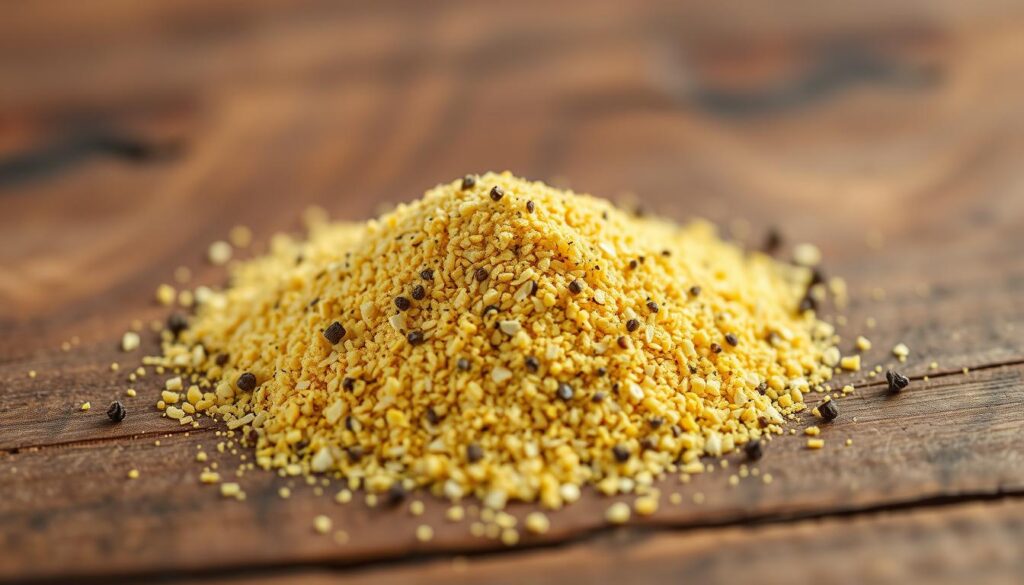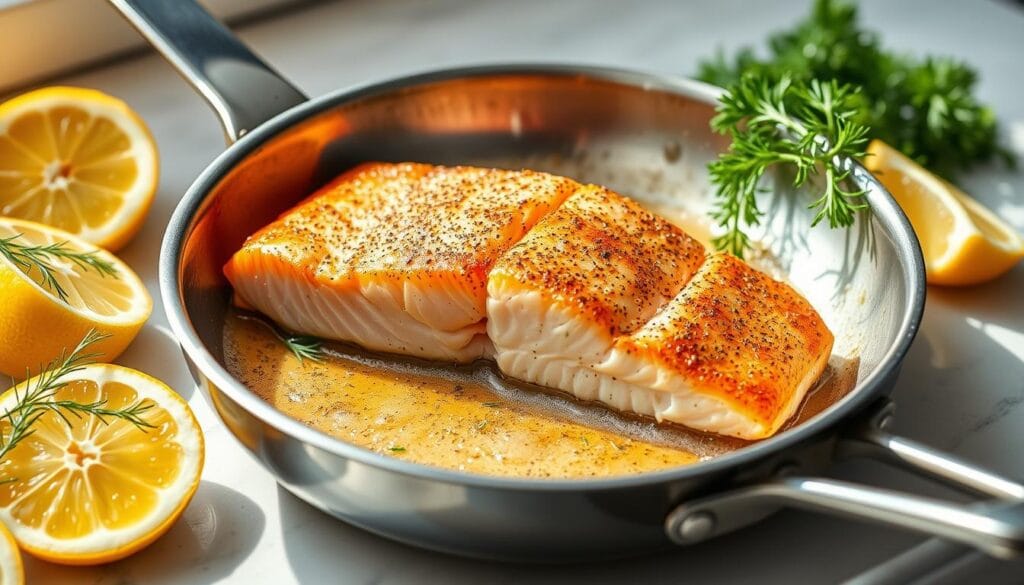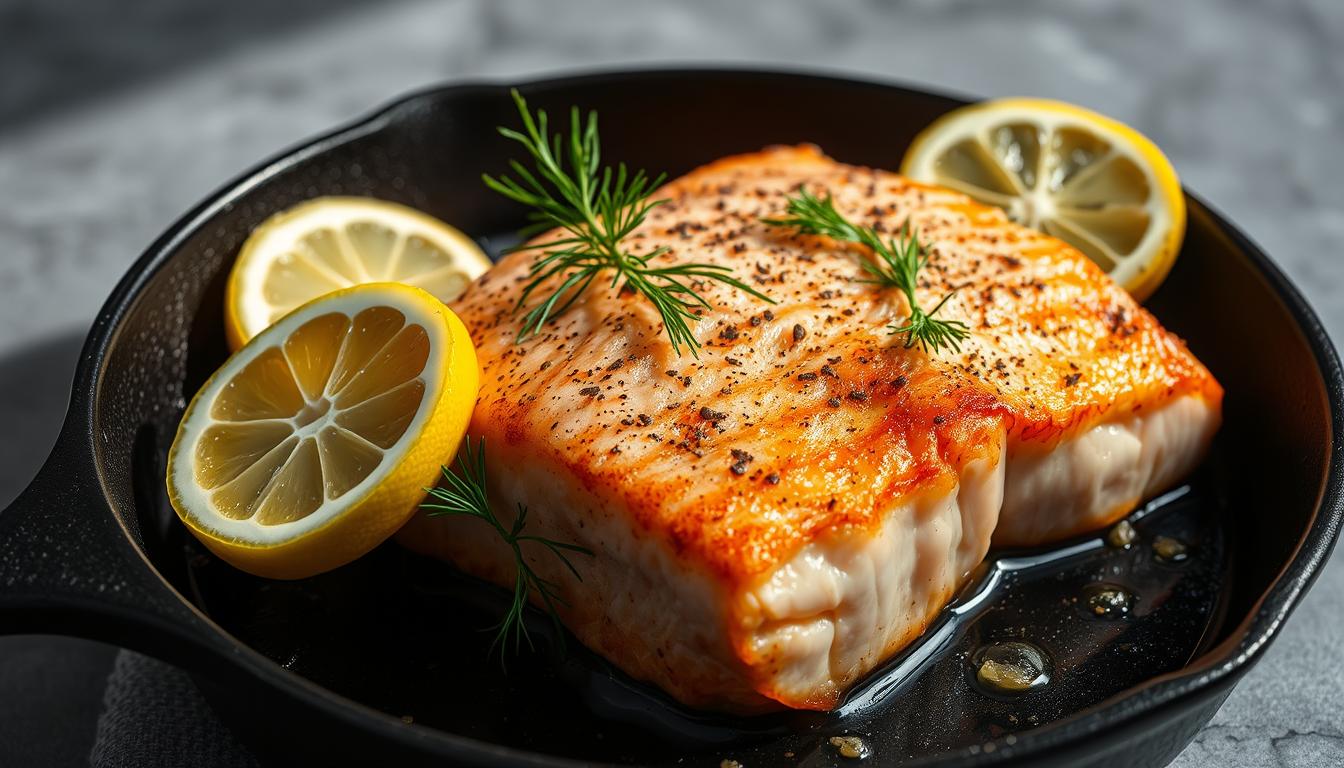Amazing Lemon Pepper Salmon Recipe You’ll Love
Table of Contents
Looking for a quick, tasty, and healthy meal? You’re in the right spot! Our Lemon Pepper Salmon is a flavorful and nutritious dish. It’s easy to make and perfect for a weeknight dinner.
This dish is a game-changer, great for those with dietary needs. It’s gluten-free, dairy-free, and paleo-friendly. It’s simple to make with just a few ingredients. This means you can enjoy a delicious meal without spending hours cooking.
Key Takeaways
- Quick and easy meal preparation
- Gluten-free, dairy-free, and paleo-friendly
- Packed with flavor and nutrients
- Perfect for weeknight dinners
- Simple ingredients and preparation
The Perfect Weeknight Dinner Solution
Salmon is a great choice for a weeknight dinner. It’s full of nutrients and easy to make. Our lemon pepper salmon recipe is quick, delicious, and healthy. It’s perfect for busy evenings.
Why Salmon Is an Excellent Protein Choice
Salmon is a top-notch protein choice. It’s loaded with omega-3 fatty acids, good for your heart and brain. It also has lots of protein, vitamins, and minerals. This makes it a great part of a healthy diet.
The Magic of Lemon and Pepper Combination
The mix of lemon and pepper makes salmon taste amazing. Lemon’s citrusy flavor pairs well with the fish, while pepper adds a nice kick. This simple seasoning brings out the best in salmon, making it a joy to eat.
| Nutrient | Salmon (100g) | With Lemon Pepper Seasoning (100g) |
|---|---|---|
| Calories | 210 | 220 |
| Protein | 35g | 36g |
| Omega-3 Fatty Acids | 1.8g | 1.9g |
| Vitamin D | 60% DV | 65% DV |
Health Benefits of Salmon with Lemon Pepper
Fresh salmon with lemon pepper is packed with nutrients that boost your health. It combines salmon’s nutritional benefits with lemon’s, making it a tasty and healthy meal.
Nutritional Profile of Salmon
Salmon is known for its high nutritional value. It’s rich in omega-3 fatty acids and protein.
Omega-3 Fatty Acids and Heart Health
Omega-3 fatty acids in fresh salmon are key for heart health. They reduce inflammation and improve blood lipids. This lowers the risk of heart disease.
Protein Content and Muscle Building
Salmon’s high protein supports muscle building and repair. It’s great for those wanting to build muscle or recover from workouts.
How Lemon Enhances Nutritional Value
Lemon adds flavor to salmon and boosts its nutritional value. Lemons are full of vitamin C, which strengthens the immune system.
| Nutrient | Benefit | Source |
|---|---|---|
| Omega-3 Fatty Acids | Heart Health | Fresh Salmon |
| Protein | Muscle Building | Salmon |
| Vitamin C | Immune System Boost | Lemon |
Essential Ingredients for Perfect Results
To get perfect results with your Lemon Pepper Salmon, start with the right ingredients. The quality of your dish depends on the freshness and type of ingredients. This section will guide you through the essential ingredients for a delicious Lemon Pepper Salmon.
Choosing the Right Salmon Fillets
The foundation of a great Lemon Pepper Salmon is the salmon fillet itself. You have several options, including wild or farm-raised, and fresh or frozen.
Wild vs. Farm-Raised Salmon
Wild salmon has a rich flavor and firm texture. Farm-raised salmon is more affordable and sustainable. Your choice depends on your preference and budget.
Fresh vs. Frozen Options
Fresh salmon fillets are ideal for immediate use, offering a superior taste and texture. Frozen salmon can be just as good if thawed properly. It’s often more convenient for meal planning.
Fresh vs. Dried Herbs and Spices
Fresh herbs like parsley and dill add a bright, fresh flavor. Dried herbs are more concentrated and convenient. For the Lemon Pepper seasoning, a mix of freshly ground black pepper and lemon zest is essential. You can also use store-bought Lemon Pepper seasoning as a convenient alternative.
Optional Ingredients for Enhanced Flavor
To enhance the flavor of your Lemon Pepper Salmon, consider adding garlic, lemon juice, or olive oil. These ingredients add depth and richness to your dish.
Some recipes suggest adding paprika or chili flakes for an extra kick. Experimenting with different combinations can help you find your perfect flavor.
| Ingredient | Fresh | Dried |
|---|---|---|
| Herbs (e.g., Parsley, Dill) | Bright, fresh flavor | More concentrated, convenient |
| Lemon Pepper Seasoning | Freshly ground black pepper and lemon zest | Store-bought for convenience |
| Garlic | Minced, adds depth | Powdered, for a subtle flavor |
Kitchen Tools You’ll Need
To make a delicious lemon pepper salmon, you’ll need some key kitchen tools. The right equipment makes cooking easier and more fun.
Essential Equipment
You’ll need a sharp knife for filleting, a cutting board for prep, and a baking sheet or skillet for cooking. Don’t forget a cracked pepper grinder to add that special pepper touch to your salmon.
Nice-to-Have Tools for Easier Preparation
While not a must, a kitchen scale helps with accurate ingredient measurements. A zester makes adding fresh lemon zest easy. Also, a fish spatula is handy for cooking the salmon in a pan.
Preparing Your Salmon
Before you start cooking your salmon, it’s key to prepare it right. This ensures the best taste and texture. Several important steps can greatly affect your dish’s outcome.
Properly Cleaning and Patting Dry
First, clean the salmon under cold water to remove blood and debris. Then, pat it dry with paper towels, focusing on the skin side if it has skin. This helps seasonings stick and ensures even cooking.
Removing Pin Bones
Salmon often has pin bones, which are small and can be a nuisance. To get rid of them, feel for the bones with your fingers and then use tweezers or needle-nose pliers to pull them out. This makes your meal smoother.
Portioning for Even Cooking
For large salmon fillets, cut them into smaller pieces for even cooking. Make sure each piece is the same size. This is crucial for baking or pan-searing.
| Preparation Step | Importance | Tips |
|---|---|---|
| Cleaning and Patting Dry | Ensures even cooking and better seasoning adherence | Use cold water and paper towels |
| Removing Pin Bones | Improves eating experience | Use tweezers or needle-nose pliers |
| Portioning | Ensures uniform cooking | Cut into uniform pieces |
Creating the Perfect Lemon Pepper Seasoning
A well-balanced lemon pepper seasoning can make all the difference in your salmon’s flavor profile. This seasoning is a crucial component that elevates the dish from good to great.
Homemade vs. Store-Bought Options
When it comes to lemon pepper seasoning, you have two main options: making it from scratch or buying it from the store. Making your own seasoning allows you to customize the flavor to your liking and avoid any preservatives found in commercial products.
On the other hand, store-bought lemon pepper seasoning can be convenient and consistent. But, it may lack the freshness and personal touch that homemade seasoning provides.
Balancing Flavors for Optimal Taste
To achieve the perfect balance, you need to consider the ratio of lemon zest to pepper and other ingredients. A good lemon pepper seasoning should have a harmonious blend of citrusy and spicy flavors.
Getting the Right Lemon Zest Ratio
The lemon zest adds a bright, citrusy flavor. Use a fine grater to get the zest without the bitter white pith. Aim for a ratio that provides a noticeable lemon flavor without overpowering the salmon.
Choosing the Best Pepper Grind
The type of pepper grind can affect the overall texture and flavor. A coarse grind provides a nice crunch, while a finer grind blends more smoothly into the dish. Choose based on your personal preference.

The Ultimate Lemon Pepper Salmon Recipe
Get ready to elevate your dinner game with this easy-to-follow lemon pepper salmon recipe. It’s not only delicious but also full of nutrients. It’s a great choice for a weeknight dinner.
Marinating Techniques
Marinating is key in preparing your lemon salmon. Mix lemon juice, olive oil, minced garlic, and herbs like parsley or dill in a bowl. Place the salmon fillets in a shallow dish, pour the marinade over them, and refrigerate for at least 30 minutes or up to 2 hours for more flavor.
Oven Baking Method
Baking your salmon in the oven is a healthy and easy method. Preheat your oven to 400°F (200°C). Remove the salmon from the marinade, letting any excess liquid drip off. Season with lemon pepper seasoning. Place the salmon on a baking sheet lined with parchment paper and bake for 12-15 minutes, or until cooked through.
Pan-Searing Alternative
If you prefer a crispy exterior on your lemon pepper salmon, pan-searing is the way to go. Heat a skillet over medium-high heat and add a small amount of oil. Place the marinated salmon fillets in the skillet, skin side up (if they have skin). Cook for 3-4 minutes on each side, or until cooked through. Serve immediately.
Both baking and pan-searing methods yield delicious results. You can choose based on your preference or the texture you’re aiming for.
How to Tell When Your Salmon Is Perfectly Cooked
Cooking salmon just right is key to a tasty dish. If it’s overcooked, it becomes dry and tough. On the other hand, undercooking can make it unsafe. So, how do you know when it’s just right?
Visual Indicators of Doneness
One way to check if your salmon is cooked is by looking at it. Perfectly cooked salmon should have an opaque color and flake easily with a fork. If it’s still translucent, it needs more cooking time.
Another way is to check the texture. Cooked salmon should be firm but still moist. If it feels soft or squishy, it’s likely undercooked.
Internal Temperature Guidelines
For a more precise check, use a meat thermometer. The recommended internal temperature is 145°F (63°C). Insert the thermometer into the thickest part of the fillet to get an accurate reading.
| Cooking Method | Internal Temperature | Visual Check |
|---|---|---|
| Baking | 145°F (63°C) | Opaque and flakes easily |
| Pan-Searing | 145°F (63°C) | Firm to the touch |
Common Mistakes to Avoid When Cooking Salmon
For a tasty salmon dish, it’s important to avoid common mistakes. Several errors can make your salmon less than perfect. Knowing these can help you cook better.
Overcooking Issues and Solutions
One big mistake is overcooking salmon. This makes the fish dry and tough. To fix this, use a thermometer to check if it’s done.
Salmon is ready when it hits 145°F (63°C). You can also cook it a bit underdone. It will finish cooking after you take it off the heat.
Seasoning Pitfalls
Another mistake is using too much seasoning. Salmon can get overwhelmed by strong flavors. So, it’s all about finding the right balance.
Use herbs and spices wisely. Marinating the salmon before cooking can also boost its flavor without being too much.
Temperature and Timing Errors
Wrong temperature or timing can also mess up your salmon. Make sure your cooking area is at the right temperature.
Also, pay attention to the cooking time. It depends on the salmon’s thickness and how you cook it.
| Cooking Method | Temperature | Cooking Time |
|---|---|---|
| Oven Baking | 400°F (200°C) | 12-15 minutes |
| Pan-Searing | Medium-High Heat | 3-4 minutes per side |
By avoiding these mistakes, you can make a great salmon dish. Adding these tips to your weekly meal plan will make cooking salmon easy.

Meal Prep and Storage Tips
Preparing your lemon pepper salmon in advance can change your weekly meal plans. With a little planning, you can enjoy this dish all week long.
Making Ahead for Weekly Meal Plans
You can cook your lemon pepper salmon ahead of time. Just cook it, then store it in the fridge or freezer. This makes it easy to add fresh salmon to your meals.
To make ahead, cook the salmon, let it cool, and portion it out. This way, you can have a healthy meal anytime.
Proper Storage Methods
Storing cooked salmon right is key to keeping it fresh and safe. Store it in an airtight container in the fridge at 40°F (4°C) or below. If you need to store it longer, freeze it.
Freezing? Place the salmon in a single layer on a baking sheet, freeze, then bag it. This stops it from sticking together.
Reheating Without Drying Out
To reheat your lemon pepper salmon without drying it, use gentle heat. Reheat it in the oven at a low temperature, wrapped in foil. Or, use a skillet with a bit of liquid over low heat.
Avoid microwaving to prevent dryness. If you must microwave, cover it and heat in short bursts, checking until warm.
Conclusion
You now have a complete guide to making a delicious Lemon Pepper Salmon dish. It’s perfect for any meal and is both tasty and healthy. It’s full of nutrients and flavor.
This recipe is ideal for a weeknight dinner because it’s fast to make and cook. It’s simple and good for you, making it great for sharing with loved ones.
By following the steps in this article, you can make a standout Lemon Pepper Salmon dish. It’s sure to become a hit at home. So, try out this recipe and enjoy the amazing results.

